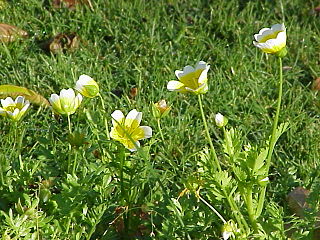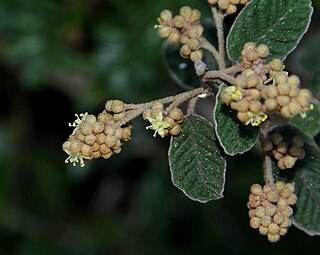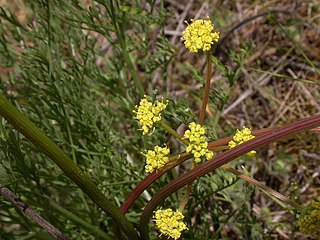
Limnanthes douglasii is a species of annual flowering plant in the family Limnanthaceae (meadowfoam) commonly known as Douglas' meadowfoam or poached egg plant. It is native to California and Oregon, where it grows in wet, grassy habitat, such as vernal pools and spring meadows. It can grow in poorly drained clay soils. The plant was collected by the Scottish explorer and botanist David Douglas, who worked on the west coast of America in the 1820s.

The Limnanthaceae are a small family of annual herbs occurring throughout temperate North America. There are eight species and nineteen taxa currently recognized. Members of this family are prominent in vernal pool communities of California. Some taxa have been domesticated for use as an oil seed crop. Some members are listed as threatened or endangered and have been the focus of disputes over development plans

Limnanthes, the type genus of the family Limnanthaceae, consists of annual herbaceous plants commonly known as the meadowfoams. The seven species are all native to coastal and adjoining regions of western North America, where they typically grow in marshy habitats, such as the margins of vernal pools. Some are endemic to California.

Streptanthus glandulosus subsp. niger is an endangered subspecies of flowering plant within the family Brassicaceae. Like other genus members, this herb has wavy petal margins with perimeter calluses that discourage larval herbivory. This plant is endemic to the Tiburon Peninsula of Northern California, and occurs at elevations below 150 m on serpentine grasslands. The common name for this subspecies is Tiburon jewelflower or black jewelflower. This annual herb blooms in May and June and displays dark purple sepals. The etymology of this genus scientific name derives from the Greek word streptanthus, meaning twisted flower, with reference to the notable wavy margins of the petals. The subspecies name niger relates to the color of the seeds being black, although an alternate account cites the dark color of the petals as the source of the appellation.

Arctostaphylos tomentosa is a species of manzanita known by the common name woollyleaf manzanita or woolley manzanita. This shrub is endemic to California.

Chloropyron molle is a species of flowering plant in the family Orobanchaceae.

The North Table Mountain Ecological Reserve is a nature reserve of 3,315 acres (13.42 km2) located three miles (5 km) north of Oroville, in Butte County, northern California. The land was acquired by the state in October, 1993.

Orobanche californica, known by the common name California broomrape, is a species of broomrape. It is a parasitic plant growing attached to the roots of other plants, usually members of the Asteraceae.

Paeonia daurica is a perennial herbaceous plant belonging to the peony family. It has slender carrot-shaped roots, leaves mostly consisting of nine leaflets, with one flower per stem. The flower is subtended by none to two leafy bracts, and has two or three sepals, five to eight petals, and many stamens. The subspecies vary in the colour of the petals, the size and shape of the leaflets, and the hairiness of the leaflets and the carpels. Paeonia daurica can be found from the Balkans to Iran, and the Crimea to Lebanon, with the centre of its distribution in the Caucasus. It is also cultivated as an ornamental.
Ribes lasianthum is a species of currant known by the common names alpine gooseberry and woolly-flowered gooseberry. It is native to California, where it can be found in the San Gabriel Mountains and the Sierra Nevada, its distribution extending just into Nevada.

Silene campanulata is a species of flowering plant in the family Caryophyllaceae known by the common names Red Mountain catchfly and bell catchfly. It may be a synonym of Silene greenei.

Streptanthus glandulosus is a species of flowering plant in the mustard family known by the common name bristly jewelflower. It is native to California and southwestern Oregon, where it grows in many types of habitat, including grassland, chaparral, and woodlands. Genetic and other analyses indicate that it is a species complex with ten subspecies which evolved as populations were isolated from each other. The complex includes subspecies previously considered separate species, such as the rare Tiburon jewelflower endemic to the San Francisco Bay Area. Plants in the complex are variable. In general they are annual herbs growing 10 centimeters to over a meter in height. They may be hairless hairy to bristly. The ephemeral basal leaves have blades borne on winged petioles. Leaves higher on the stem are linear to lance-shaped and clasp the stem at their bases. Flowers occur at intervals along the upper stem. Each flower has an urn-shaped calyx of sepals one-half to over one centimeter long which can be almost any color from white to yellowish to pink or purple to nearly black. Purple, white, or purple-veined white petals emerge from the tip. The fruit is a straight or curving silique up to 11 centimeters long.

Pomaderris oraria, commonly known as Bassian dogwood, is a species of flowering plant in the family Rhamnaceae and is endemic to south-eastern Australia. It is a compact shrub with hairy branchlets, hairy, elliptic leaves and panicles of hairy, greenish to cream-coloured or crimson-tinged flowers.

Hibbertia stricta is a species of flowering plant in the family Dilleniaceae and is endemic to New South Wales. It is a small, usually upright shrub with hairy foliage, linear leaves and yellow flowers with six or seven stamens arranged around two woolly-hairy carpels.

Lomatium cookii is a rare species of flowering plant in the carrot family known by the common names Cook's lomatium and agate desertparsley. It is endemic to Oregon in the United States, where it grows in only two valleys. It is a federally listed endangered species.

Eremophila obovata is a flowering plant in the figwort family, Scrophulariaceae and is endemic to Australia. It is a low, compact shrub with lilac to purple flowers growing mainly in the Northern Territory and Queensland but also Western Australia, South Australia and New South Wales.
Eremophila simulans is a flowering plant in the figwort family, Scrophulariaceae and is endemic to Western Australia. It is an erect shrub with broad, serrated leaves and violet to purple flowers.

Zieria odorifera, commonly known as the fragrant zieria, is a plant in the citrus family Rutaceae and is endemic to inland New South Wales. It is an aromatic shrub with ridged branches, leaves composed of three leaflets and groups of mostly three pale to deep pink, four-petalled flowers in spring.

Boronia juncea is a plant in the citrus family, Rutaceae and is endemic to the far south-west of Western Australia. It is an erect shrub with linear, short-lived leaves and groups of up to eight white to pink, four-petalled flowers.

Xylonagra arborea is a flowering plant endemic to the western side of the Baja California Peninsula. It is a bushy shrub distinguished by showy, scarlet flowers that are attractive to hummingbirds. It is the sole species in the genus Xylonagra, which belongs to the family Onagraceae.



















